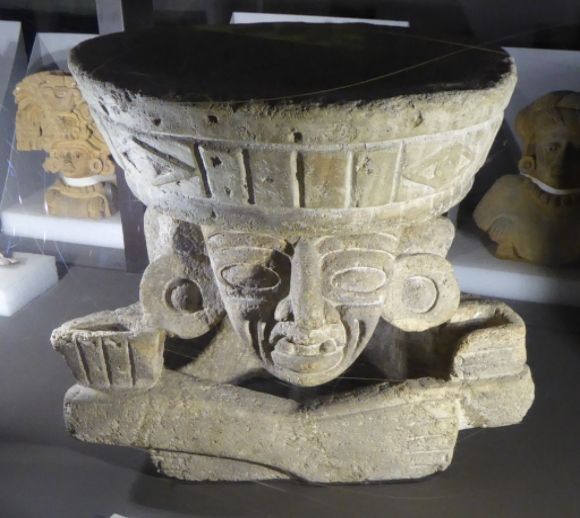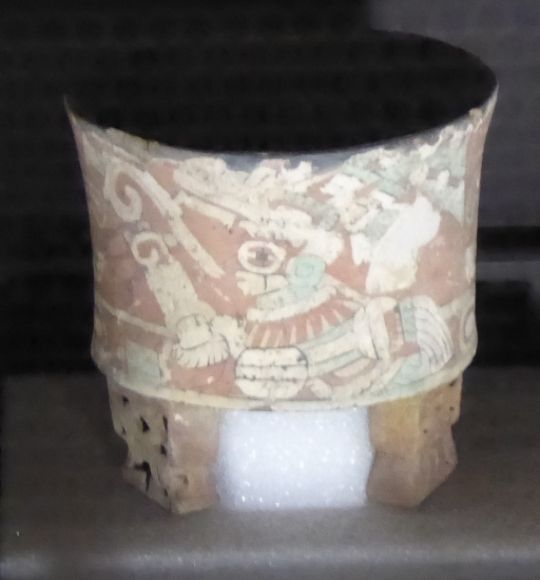In major museums, only a small fraction of the artifacts held by the museum are on display and interpreted for the public. Most of the museum’s artifacts are in vaults where they are available only to researchers. The Los Angeles County Museum of Natural History maintains a Visible Vault in which visitors can view hundreds of archaeological artifacts. The Visible Vault includes archaeological treasures from Aztec and other Mexican cultures.
About the Aztec
When the Spanish began their conquest of Mexico in 1519 they encountered a powerful nation known as the Aztec. The Aztec called themselves Mexica and from this the name Mexico is derived.
According to the Museum display:
“Recorded in native manuscripts, or codices, and Spanish documents, their empire was built on a massive political economy, an elaborate and complex technology, as well as on deep religious and ritual traditions. The Aztec practice of human sacrifice often overshadows other aspects of this impressive ancient civilization. Nevertheless, some of the most extraordinary objects produced by the Aztec clearly reflect a religious and ritual focus on sacrifice and related themes.”
The rise of the Aztec empire really began in 1150 with the fall of the Toltec empire. The Toltecs had established their state in Tula, which was to the north of what would become Tenochtitlan. Their empire spread through most of central Mexico. After a period of droughts and internal factional conflict, the city collapsed and was burned and looted, possibly by the Chichimeca (the “wild” tribes to the north).
The fall of the Toltec empire was followed by a period in which rival states battled for power. These states included the Zapotecs, centered at Mitla, the Mixtecs, in the northern Oaxaca area, and the Tarascan kingdom, plus the Chichimeca.
By 1200, the Valley of Mexico contained a number of moderately sized city-states. The Aztec, who arrived in the Valley about 1248, adopted some of the key organizational and ideological principles which they learned from the refugee Toltecs. These included the ruling elite or pipilitin and the requirement that only a descendant from a royal Toltec dynasty could become the emperor.
In 1300, the Aztec were still a small tribe. In addition to knowing how to cultivate the land, the Aztec were fierce warriors who were inspired by their war god Huitzilopochtli (which means “hummingbird on the left”). The Aztecs were vagrants continually trying to find a territory to occupy. All of the good land in the Valley of Mexico was already occupied by city-states. Thus, the Aztec offered their services as mercenaries for these local rulers. They often offended these rulers with their barbarous behavior and their capture of local women for wives.
In 1323, they were working for the Coluacan (also spelled Culhuacan) people. Coluacan, located in the southern portion of the Valley of Mexico, was the city-state to which the Toltec nobility had fled following the collapse of their empire.
In 1367, the Aztec used their military might to support the nearby kingdom of Tepanec that was expanding on the mainland, then ruled by Tezozomoc. As the Tepanec expanded their rule over more and more city-states in the Valley of Mexico, the Aztec benefited from their alliance with the Tepanec. From this alliance, the Aztec learned about the techniques which the Tepanec used to build and rule their empire.
In 1426, the old ruler Tezozomoc died and was replaced by his son Maxlatzin. He was concerned that the Aztecs had been growing too strong under the Tepanec’s protection. He therefore sought to reduce the Aztec’s power in 1427. At this time, the Aztec’s third king died and was replaced by Itzcoatl, who chose Tlacaelel, a brilliant military strategist, as his chief adviser. The two of them decided to resist and fight rather than submit to Maxlatzin’s threats and pressure. Within a year, the Aztecs had crushed the Tepanec and destroyed their imperial city. So now the Aztec had become the greatest state in Mexico.
With the help of Tlacaelel, Itzcoatl reduced the power of the other nobles, and turned himself into an absolute ruler. He developed a new vision of the Aztec as the “chosen people” who were the “true heirs” to the Toltec. The Aztec rewrote history to link the Aztec to the Toltec and to show that the Aztec were the heirs, the direct descendants, of the Toltec nobility.
The next Aztec emperor, Motechuhzoma Ilhuicamina ruled from 1440-1469. With Tlacaelel’s help, he set up a Triple Alliance between Tenochtitlan and two neighboring states – Texcoco and Tlacopan – to carry out the “Flowery War” – the continual fight against other states to capture victims to sacrifice to the sun god.
In 1469, Axayacatl became emperor and ruled until 1481. Under his rule, the Aztec empire expanded even further and most of central Mexico came under Aztec domination. Ahuitzotl ruled the Aztec from 1486 until 1502. He was followed by Motecuhezoma Xocoyotzin who ruled until conquered by the Spanish. Under his rule, the Aztec empire faced increasing challenges due to internal resistance and rebellion.
The Visible Vault
According to the Museum display:
“We have selected some objects to feature on exhibition-quality mounts, but most of the six hundred items are displayed in storage mounts that use archival materials ideal for long-term storage. The white band around some of the artifacts is unbleached cotton twill tape that is often used to secure objects in case of an earthquake. We invite you to explore the selected highlights of this rich collection while taking a rare look at how these objects are cared for behind the scenes.”
The Artifacts
Shown below are some of the Aztec and other Mexican artifacts which are in the Museum’s Visible Vault.
 Shown above is an Old Man Fire God (Huehueteotl) censer. Huehueteotl is one of the oldest Mesoamerican deities.
Shown above is an Old Man Fire God (Huehueteotl) censer. Huehueteotl is one of the oldest Mesoamerican deities.
 Shown above is the Feathered Serpent.
Shown above is the Feathered Serpent.
According to the Museum display:
“Stone representations of serpents were common architectural features in Central Mexico during the post-classic period. One of the most important religious symbols, the serpent stood for transformation, rebirth, and fertility. The feathered serpent was a representation of Quetzalcoatl, a primary deity in the Aztec pantheon.”
 Shown above is a basalt basin known as cuahxicalli which held sacrificial hearts and blood.
Shown above is a basalt basin known as cuahxicalli which held sacrificial hearts and blood.
According to the Museum display:
“The Aztecs believed sacrifice was necessary to continue the daily circle of life. They sacrificed humans to their gods to perpetuate the great cosmic order of the world. This basalt basin, called a cuahxicalli, was created specifically to hold sacrificial hearts and blood.”
 While the Mesoamerican cultures, such as the Aztec, used wheels in things like the toy shown above, they did not develop wheeled vehicles such as carts and wagons for transporting people and goods.
While the Mesoamerican cultures, such as the Aztec, used wheels in things like the toy shown above, they did not develop wheeled vehicles such as carts and wagons for transporting people and goods.
 Shown above is a block with glyph carvings representing Queztalcoatl (Feathered Serpent) with the Morning Star emerging from its jaws.
Shown above is a block with glyph carvings representing Queztalcoatl (Feathered Serpent) with the Morning Star emerging from its jaws.
 Shown above is a woman wearing a decorated skirt. This figure is from western Mexico.
Shown above is a woman wearing a decorated skirt. This figure is from western Mexico.
 Shown above is a marriage pair.
Shown above is a marriage pair.











Ancient America
More about the Aztec from this series:
Ancient Mexico: Aztec Time
Ancient America: Aztec Agriculture
Ancient America: Aztec Social Organization
Ancient America: Aztec Metalwork
Ancient Mexico Some Aztec Gods
Ancient America: The Rise of the Aztec Empire
Ancient Religions: An Aztec Creation Story


